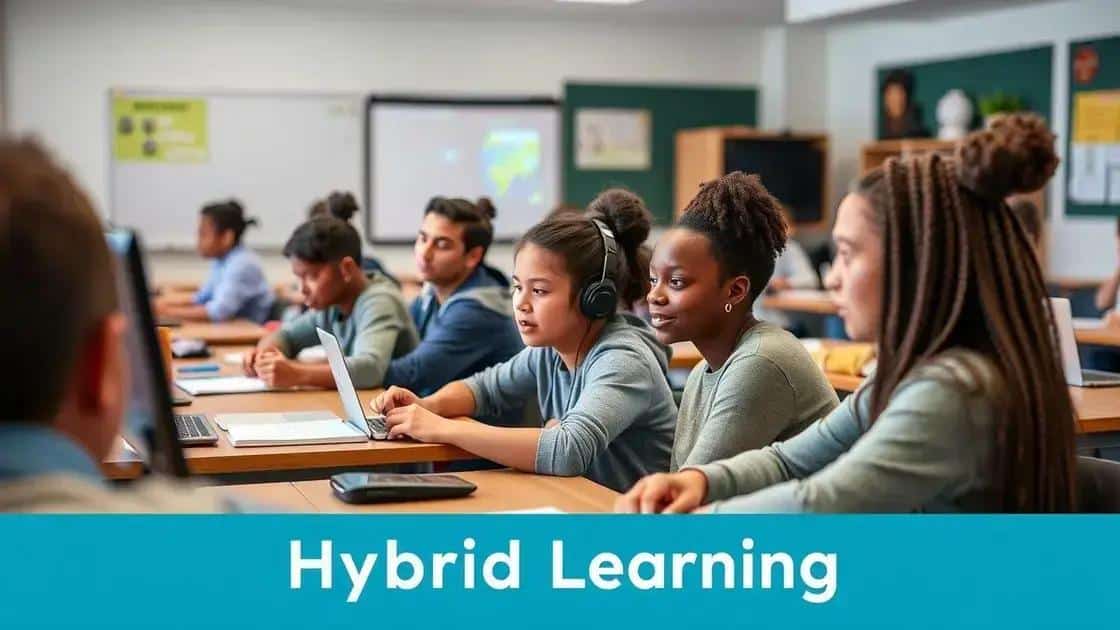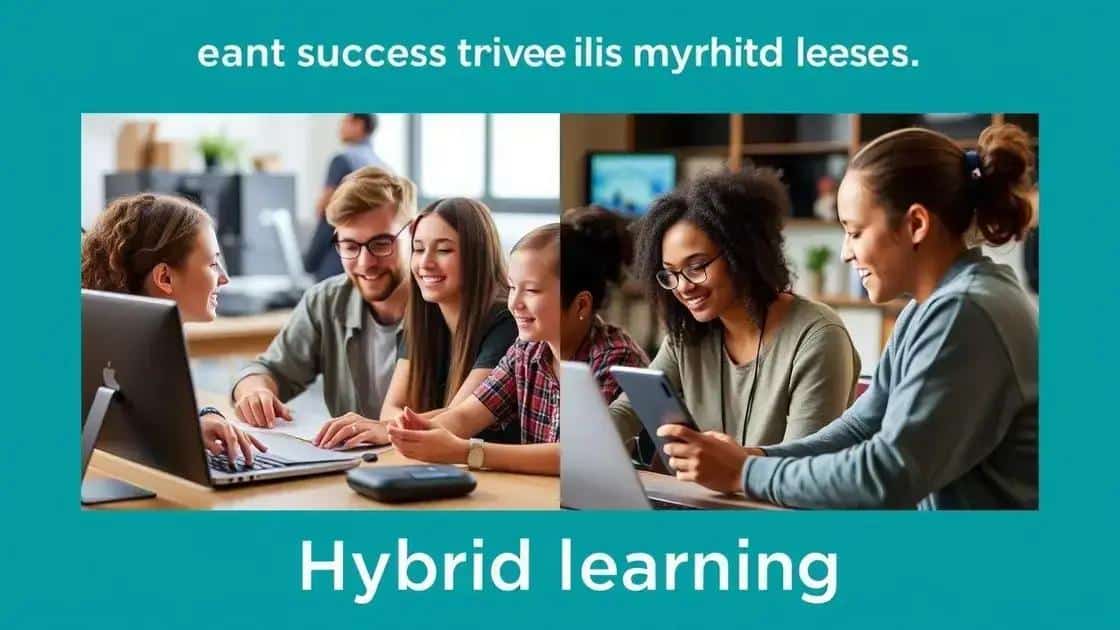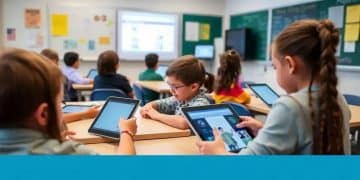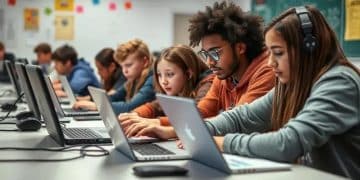Hybrid learning success trends: How to thrive in education

Hybrid learning success trends highlight the effective integration of online and in-person education, enhancing flexibility, personalized experiences, and overall student engagement while addressing challenges through technology and communication.
Hybrid learning success trends are reshaping education as we know it. Have you noticed how blending online and in-person classes can enhance the learning experience? Let’s explore this evolving landscape together.
Understanding hybrid learning models
Understanding hybrid learning models is essential for grasping how education evolves today. These models blend traditional face-to-face learning with online education methods, offering flexibility and personalized learning experiences.
The Basics of Hybrid Learning
There are several key components to consider when discussing hybrid learning models. These elements include the blend of in-person and virtual instruction, usage of technology, and the dynamics of student engagement.
Key Components
- Flexibility: Students can learn at their own pace, choosing when and where to study.
- Customization: Learners benefit from tailored experiences that suit their personal learning styles.
- Accessibility: Online resources can often be accessed anytime, making education more inclusive.
- Engagement: Interactive online tools encourage participation and collaboration among peers.
As you explore hybrid learning models, you’ll notice how they cater to different types of learners. For instance, some students thrive on the face-to-face interaction while others may prefer the independence of online studies. This flexibility allows educators to create a more effective learning environment.
Technology plays a crucial role in these models. Educators use various online platforms and tools to enhance the learning experience. By incorporating videos, discussion forums, and quizzes into their teaching, they keep students engaged. Moreover, these resources can reinforce the material learned during in-person classes, providing a comprehensive approach to education.
Benefits of Hybrid Learning
There are many benefits to adopting a hybrid learning model. Students often report feeling more empowered and in control of their learning. They appreciate the ability to choose how they access content and interact with educators and peers.
In addition to student benefits, teachers also gain from this approach. They can develop their skills in digital technologies and apply innovative teaching strategies. This not only enriches their professional development but also prepares them for future educational trends.
Embracing the hybrid learning model means recognizing the importance of a balanced approach to education. It acknowledges that learning is not one-size-fits-all and that adapting to the needs of students is crucial for success.
Current success trends in hybrid learning

Current success trends in hybrid learning showcase the evolving landscape of education. As more institutions adopt these blended models, understanding what works can help shape future practices.
Emerging Trends
One of the key trends is the increased integration of technology. Educators are now utilizing various digital tools that facilitate interactive and engaging learning experiences. This approach has shown to improve student motivation and participation.
Key Success Factors
- Personalized Learning: Tailoring education to meet individual student needs enhances effectiveness.
- Engagement Tools: Interactive platforms encourage students to connect with their peers and instructors.
- Data-Driven Insights: Using analytics helps educators assess student performance and adapt their teaching methods.
- Flexible Scheduling: Allowing students to access courses at their own convenience promotes a better balance between studies and personal commitments.
Another notable trend is the focus on fostering collaborative learning environments. Students engage more effectively when they work together, sharing ideas and resources. Tools like discussion boards and group projects support this collaboration.
Additionally, training for educators is becoming a priority. Professional development programs are equipping teachers with the skills they need to succeed in hybrid learning environments. With proper support, they can better facilitate learning and adapt to new technologies.
Positive Outcomes
The positive outcomes of hybrid learning are evident in improved student satisfaction and achievement. Many students report feeling more engaged and responsible for their learning. As a result, educational institutions are recognizing the importance of maintaining hybrid models.
These trends are reshaping the future of education. By focusing on what works, schools can continue to harness the benefits of blending face-to-face and online learning for a richer educational experience.
Challenges faced in hybrid education
Challenges faced in hybrid education are prevalent as institutions seek to implement these innovative teaching models. While the benefits are clear, various obstacles can hinder success.
Common Challenges
One major challenge is ensuring equal access to technology. Not all students have reliable internet or devices, which can create educational gaps. This lack of access may lead to disengagement and discourage participation in online components of the curriculum.
Teacher Adaptation
Another significant issue is the need for teachers to adapt to new teaching methods. Educators must learn to use various digital tools effectively while balancing traditional teaching styles. This transition can be overwhelming and may require extensive training and support.
Student Engagement
- Maintaining motivation: Students can struggle to stay engaged during online classes.
- Social interaction: Limited face-to-face interaction may affect students’ social skills and sense of community.
- Distractions: Home environments can introduce distractions that hinder focus during learning.
- Assessment: Evaluating student performance in a hybrid model can be more challenging.
Furthermore, creating a cohesive learning experience is difficult in a hybrid setup. Coordinating between online and in-person activities requires careful planning to ensure that all students are receiving the same quality of education.
In addition to these obstacles, the overall structure of courses must be revised. Teachers need to create lessons that work effectively in both settings, which can be time-consuming and complex.
As educators and institutions continue to navigate these challenges, communication is key. Frequent discussions between teachers, students, and parents about obstacles can help prepare for more effective solutions, fostering a smoother transition into the future of hybrid learning.
Best practices for hybrid learning implementation

Best practices for hybrid learning implementation are essential to maximizing the effectiveness of this educational approach. Understanding how to effectively blend in-person and online learning can make a significant difference in student outcomes.
Effective Planning
One best practice is thorough planning before the semester starts. Educators should develop a clear outline of the course objectives, materials, and teaching methods for both online and in-person components. By doing so, they can ensure that the transition between formats is seamless, benefiting all students.
Utilizing Technology
Another key practice is the effective use of technology. Educators can leverage interactive platforms and learning management systems to enhance the learning experience. Utilizing tools such as video conferencing, discussion forums, and collaborative documents helps keep students engaged.
Encouraging Engagement
- Active Participation: Encourage students to participate during live sessions through polls and interactive discussions.
- Group Work: Assign small group projects that combine students from both online and in-person settings.
- Regular Feedback: Provide timely feedback to allow students to understand their progress and areas for improvement.
- Office Hours: Set up virtual office hours to assist students needing extra help.
Additionally, maintaining open lines of communication is crucial. Teachers should regularly communicate with students and parents to address concerns and provide updates about the course. This transparency creates a supportive environment where students feel comfortable expressing their needs.
Professional development for educators is another important aspect. Training sessions focused on hybrid teaching strategies and technology can enhance teachers’ confidence and skills. As they become more adept at hybrid teaching, students will benefit from improved instruction.
Finally, it’s essential to collect and analyze data on student performance. Educators should regularly assess students’ progress in both online and in-person settings. This data can help refine teaching methods and better support individual learning paths, ultimately leading to more successful hybrid learning experiences.
FAQ – Frequently Asked Questions about Hybrid Learning
What is hybrid learning?
Hybrid learning combines traditional in-person classroom instruction with online educational activities, allowing for a flexible learning environment.
What are the benefits of hybrid learning?
Some benefits include flexibility in scheduling, personalized learning experiences, and access to a variety of digital resources.
How can educators effectively implement hybrid learning?
Educators can effectively implement hybrid learning by planning thoroughly, utilizing technology, and maintaining open communication with students and parents.
What are the main challenges of hybrid learning?
Challenges include ensuring equal access to technology, maintaining student engagement, and adapting teaching methods to suit both online and in-person formats.





